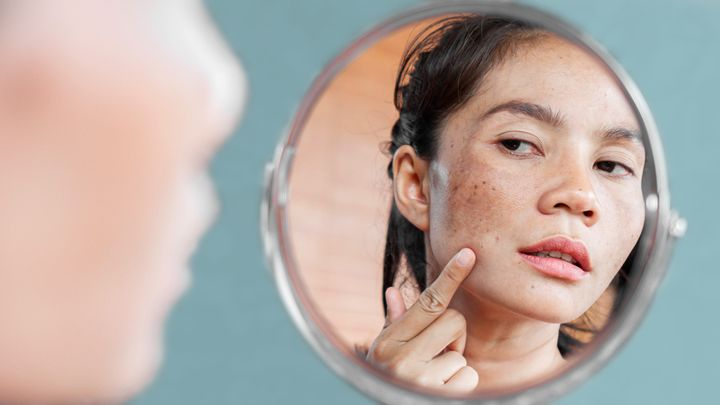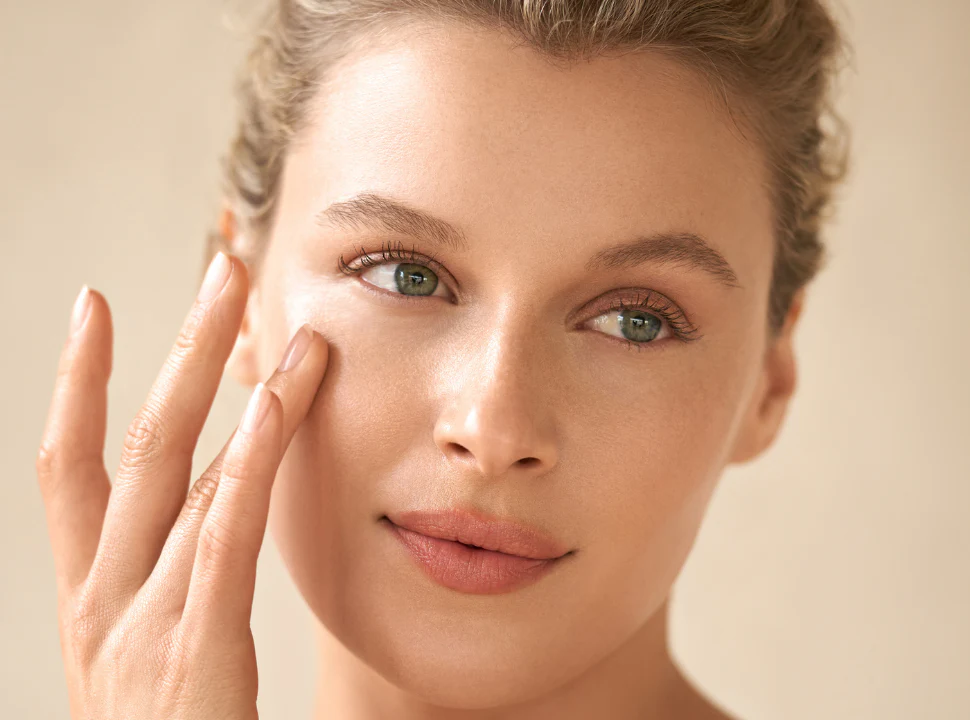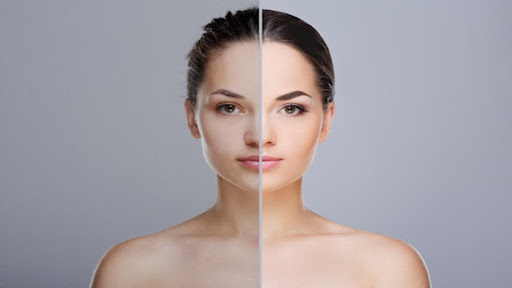

· By Sara M, Founder
The Top Ingredients That Get Rid Of Hyperpigmentation
Hyperpigmentation is a skin condition that causes dark patches or spots on the skin. It occurs when there is an increase in the production of melanin, the pigment that gives our skin its color. This can be triggered by various factors such as sun exposure, hormonal changes, and certain medications.
While hyperpigmentation is a common and usually harmless condition, it can be a source of self-consciousness and affect one's self-esteem. Luckily, there are several ingredients that have been proven to effectively reduce hyperpigmentation and restore even skin tone.
Hyperpigmentation, characterized by dark spots or patches on the skin, arises from an increased melanin production— the natural pigment that colors our skin. Triggers for this common skin condition include sun exposure, hormonal fluctuations, and certain medications. Although typically harmless, hyperpigmentation can impact self-esteem and cause self-consciousness.
Key studies, such as the research by Dayanand Raikar, et al., provide insights into the clinical profiles of facial hyperpigmentation, highlighting its prevalence, especially in women aged 20 to 40 years.
Additionally, the case study from the Australian Family Physician on minocycline-induced hyperpigmentation sheds light on drug-induced discoloration, emphasizing the importance of understanding the potential side effects of medications on skin appearance.
In this article, we will discuss the top ingredients that are known for their ability to get rid of hyperpigmentation and give you clearer, brighter skin.
What is Hyperpigmentation?

Hyperpigmentation is a common skin condition that affects people of all ages and skin types. It occurs when there is an increase in melanin production, which causes dark patches or spots to appear on the skin. This can happen due to various reasons such as sun exposure, genetics, hormonal changes, and certain health conditions.
There are different types of hyperpigmentation, including melasma, age spots, post-inflammatory hyperpigmentation (PIH), and freckles. Each type has its own specific causes and characteristics. For instance, melasma is often caused by hormonal changes during pregnancy or menopause, while PIH is a result of inflammation or injury to the skin.
Hyperpigmentation can occur on any part of the body but is most commonly found on the face, hands, and neck. It is usually harmless and does not pose any health risk, but it can be a source of self-consciousness for many people. That's why finding effective ways to reduce hyperpigmentation is important for those who are affected by it.
Causes of Hyperpigmentation
As mentioned earlier, various factors can trigger hyperpigmentation. The most common cause is sun exposure, which leads to an increase in melanin production as a natural defense mechanism against UV radiation.
Other causes include hormonal changes, such as pregnancy or menopause, which can cause an increase in melanin production. Certain medications, like birth control pills and antibiotics, can also contribute to hyperpigmentation.
Inflammation or injury to the skin can also lead to hyperpigmentation. This includes acne breakouts, eczema flare-ups, and burns. In these cases, the body produces excess melanin as part of the healing process.
Genetics may also play a role in determining one's susceptibility to hyperpigmentation. People with darker skin tones are more prone to developing hyperpigmentation because they naturally have more melanin in their skin.
Understanding the causes of hyperpigmentation is important in finding effective ways to treat and prevent it. By addressing the root cause, you can effectively manage your hyperpigmentation and achieve a clearer, even complexion.
Where Can You Get Hyperpigmentation?
Hyperpigmentation can occur on any part of the body, but some areas are more prone to developing this condition than others. The face is one of the most common places where hyperpigmentation occurs, especially on the cheeks, forehead, and upper lip. This is because these areas are often exposed to sunlight and are more susceptible to sun damage.
The hands and neck are also commonly affected by hyperpigmentation. These areas are often neglected when it comes to sun protection, making them vulnerable to UV radiation.
Other common areas for hyperpigmentation include the arms, legs, and back. These areas may not be as frequently exposed to sunlight as the face or hands, but they can still develop hyperpigmentation due to hormonal changes, genetics, and other factors.
It's important to note that anyone can develop hyperpigmentation regardless of their age or skin type. However, people with darker skin tones are more prone to developing this condition due to the higher amount of melanin in their skin.
Knowing where hyperpigmentation typically occurs can help you identify and treat it early on before it becomes more noticeable. Sun protection and proper skincare routine are crucial in preventing and managing hyperpigmentation on these areas.
Top Ingredients That Get Rid Of Hyperpigmentation

Now You might be wondering, what are the ingredients that can effectively get rid of hyperpigmentation? Here are some of the top ingredients that have been proven to reduce dark spots and give you a more even complexion.
Vitamin C
Vitamin C is one of the most popular and effective ingredients for reducing hyperpigmentation. This powerful antioxidant works by inhibiting the enzyme tyrosinase, which is responsible for melanin production.
By doing so, it helps to lighten dark spots and even out skin tone. Additionally, Vitamin C promotes collagen synthesis, which can improve the skin's texture and overall appearance. It also provides protection against sun damage by neutralizing harmful free radicals caused by UV exposure. This makes it a crucial ingredient in both treating and preventing hyperpigmentation.
To get the best results, it's recommended to use a Vitamin C serum with a concentration of 10-20%, applied daily as part of your skincare routine. Regular use can lead to brighter, clearer, and more youthful-looking skin.
Hydroquinone
Hydroquinone is a powerful skin-lightening agent that works by inhibiting melanin production. It is considered the gold standard ingredient for treating hyperpigmentation and has been used for decades with proven results.
This ingredient works by suppressing the activity of tyrosinase, thereby preventing the formation of new dark spots and reducing the appearance of existing ones. It's commonly found in over-the-counter creams, but it can also be prescribed in higher concentrations by a dermatologist for more severe cases.
It's important to note that hydroquinone may cause skin sensitivity and should only be used as directed. Long-term use of this ingredient has also been linked to potential side effects, so it's essential to consult with a dermatologist before incorporating it into your skincare routine.
Azelaic Acid
Azelaic acid is a naturally occurring substance found in grains like wheat, barley, and rye. It has been used for decades to treat hyperpigmentation due to its ability to inhibit tyrosinase activity and reduce melanin production.
In addition to lightening dark spots, azelaic acid also has anti-inflammatory properties that can help calm redness and irritation associated with hyperpigmentation. It's also effective in treating acne, making it a great multi-tasking ingredient for those with both hyperpigmentation and blemishes.
This ingredient is available over-the-counter in concentrations of 10-20%, but higher strengths can be prescribed by a dermatologist. When using azelaic acid, it's important to wear sunscreen as it may increase your skin's sensitivity to UV rays. It's also best to start with a lower concentration and gradually increase over time to avoid potential irritation.
Kojic Acid
Kojic acid is a natural compound derived from fungi that has been used in skincare for its brightening properties. Similar to other ingredients on this list, it works by inhibiting tyrosinase activity and reducing melanin production.
In addition to lightening dark spots, kojic acid also has anti-inflammatory and antioxidant properties that can help improve overall skin health. It's considered a gentler alternative to hydroquinone but may still cause irritation in some individuals.
Kojic acid is available in both over-the-counter products and prescription-strength creams. When using this ingredient, it's important to wear sunscreen as it can make your skin more sensitive to sunlight. It's also best to patch test before applying it all over the face to ensure you don't have any adverse reactions.
Niacinamide (Vitamin B3)
Niacinamide, also known as Vitamin B3, is an essential nutrient for maintaining healthy skin. In addition to its numerous benefits, such as reducing wrinkles and improving hydration levels, niacinamide also works to reduce hyperpigmentation.
This ingredient has been shown to inhibit melanin production, making it highly effective in lightening dark spots and evening out skin tone. It also has anti-inflammatory properties that can help improve redness and irritation caused by hyperpigmentation.
Niacinamide is available in various over-the-counter products, including serums and moisturizers. It's generally well-tolerated by all skin types but may cause mild irritation for those with sensitive skin. As with any new skincare ingredient, patch test before incorporating it into your routine.
Retinol (Vitamin A)
Retinol, a form of Vitamin A, is another popular ingredient for treating hyperpigmentation. It works by increasing cell turnover and promoting the growth of new, healthy skin cells. This helps to fade dark spots and reveal a brighter, more youthful complexion.
Additionally, retinol has been shown to improve collagen production, leading to firmer, smoother skin. It's also effective in reducing fine lines and wrinkles and improving overall skin texture.
Retinol is available in both over-the-counter products and prescription-strength creams. It's important to start slow when using this ingredient as it can cause irritation if not used correctly. Start with a low concentration and gradually build up tolerance over time. And as always, make sure to use sunscreen daily as retinol can increase your skin's sensitivity to sunlight.
Glycolic Acid
Glycolic acid is a type of alpha-hydroxy acid (AHA) derived from sugar cane that has been used for decades in treating hyperpigmentation. It works by exfoliating the top layer of skin, removing dead cells, and revealing brighter, more even-toned skin.
In addition to its brightening effects, glycolic acid also helps to improve overall skin texture and reduce the appearance of fine lines and wrinkles. It's available in various concentrations in over-the-counter products but can also be found in professional chemical peels for more significant results.
When using glycolic acid, it's important to start slow and patch test before applying it all over the face. This ingredient can cause dryness and irritation if not used correctly, so it's essential to follow the recommended usage and gradually increase frequency.
So these are some of the top ingredients used in treating hyperpigmentation. As always, it's crucial to consult with a dermatologist before incorporating any new skincare ingredient into your routine, especially if you have sensitive skin or previous skin conditions.
Why Hyperpigmentation Occurs

Hyperpigmentation occurs when there is an increase in melanin production, leading to areas of darker skin. This can be caused by various factors, such as sun exposure, hormonal changes, or inflammation.
Excessive UV exposure triggers the production of melanin as a protective mechanism against harmful UV rays. This results in dark spots and uneven skin tone. Hormonal changes, like those during pregnancy or menopause, can also cause an increase in melanin production.
Inflammation caused by acne breakouts, eczema, or other skin conditions can also contribute to hyperpigmentation. As the skin heals from these inflammations, it may produce excess melanin in the affected area.
It's also important to note that certain medications and medical conditions can cause hyperpigmentation as a side effect. Always consult with your doctor if you notice any changes in your skin that may be related to medication or health issues.
Tips for Preventing Hyperpigmentation
While treating existing hyperpigmentation is important, it's equally crucial to take steps to prevent it from occurring in the first place. Here are some tips to help prevent hyperpigmentation:
-
Wear sunscreen daily: Sun exposure is one of the leading causes of hyperpigmentation. Make sure to apply a broad-spectrum sunscreen with an SPF of 30 or higher every day, even on cloudy days. Plus, it helps protect against skin cancer and premature aging.
-
Avoid picking at your skin: Picking at acne or scabs can lead to inflammation and potential hyperpigmentation as the skin heals. Resist the urge to pick and instead use gentle skincare products to help clear up blemishes.
-
Be cautious with hair removal methods: Waxing and shaving can cause irritation and inflammation, which can contribute to hyperpigmentation in those areas. Consider alternative hair removal methods like laser treatments or depilatory creams.
-
Manage hormonal changes: If you experience hormonal changes due to pregnancy or menopause, try using skincare products with ingredients like niacinamide that can help control melanin production.
-
Address underlying medical conditions: Certain medical conditions, such as thyroid disorders or autoimmune diseases, can cause hyperpigmentation. It's essential to work with your doctor to manage these conditions and monitor any skin changes.
By following these tips and incorporating ingredients like niacinamide, retinol, and glycolic acid into your skincare routine, you can successfully treat existing hyperpigmentation while preventing it from occurring in the future. Remember to always prioritize sun protection and consult with a dermatologist for personalized recommendations.
FAQs
What are the best ingredients for hyperpigmentation?
Effective ingredients for hyperpigmentation include vitamin C, niacinamide, and kojic acid. These help brighten skin and reduce discoloration.
How do these ingredients remove dead skin cells?
Ingredients like alpha hydroxy acids (AHAs) and retinoids promote cell turnover, helping to remove dead skin cells and reveal brighter, more even-toned skin.
Can niacinamide help with skin discoloration?
Yes, niacinamide is known for its ability to reduce skin discoloration and improve overall skin tone, making it a top choice for treating hyperpigmentation.
Why is vitamin C effective for hyperpigmentation?
Vitamin C is a powerful antioxidant that helps lighten dark spots and prevent new ones from forming by inhibiting melanin production, making it one of the best ingredients for hyperpigmentation.
Conclusion
Hyperpigmentation is one of the most common skin concerns that can affect anyone regardless of skin color or type. Luckily, there are various ingredients and treatments available to help fade dark spots and even out skin tone.
Niacinamide, retinol, and glycolic acid are three popular ingredients used in treating hyperpigmentation by increasing cell turnover, promoting collagen production, and exfoliating the skin. However, it's important to patch test before incorporating these ingredients into your routine and consult with a dermatologist if you have sensitive skin or underlying medical conditions.
By following these tips, you can effectively treat existing hyperpigmentation while preventing it from becoming a recurring issue in the future. Remember to always prioritize sun protection and consult with a dermatologist for personalized recommendations.